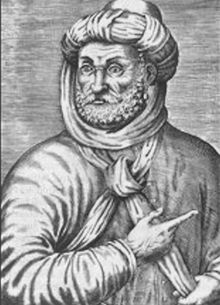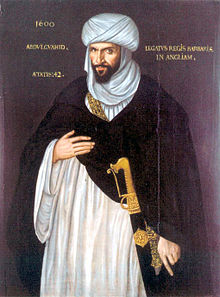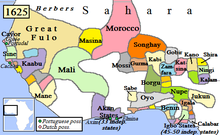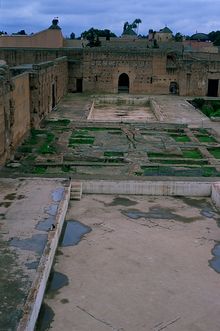- Ahmad al-Mansur
-
Ahmad I al-Mansur Sultan of Morocco 

Reign 1578 - 1603 Coronation 1578 Born 1549 Birthplace Fes, Morocco Died 1603 Place of death Outskirts of Fes, Morocco Predecessor Abd al-Malik Successor Zidan Abu Maali (in Marrakesh)
Abou Fares Abdallah (in Fes)Offspring Zidan Abu Maali
Abou Fares AbdallahReligious beliefs Islam Ahmad I al-Mansur (Arabic: أحمد المنصور السعدي, also El-Mansour Eddahbi [the Golden], Arabic: أحمد المنصور الذهبي; and Ahmed el-Mansour) (1549 in Fes[1] - 25 August 1603, outskirts of Fes[2][3]) was Sultan of the Saadi dynasty from 1578 to his death in 1603, the sixth and most famous of all rulers of the Saadis. He was the fifth son of Mohammed ash-Sheikh who was the first Saadi sultan of Morocco. Ahmad al-Mansur was an important figure in both Europe and Africa in the sixteenth century, his powerful army and strategic location made him an important power player in the late Renaissance period.
Contents
Exile to the Ottoman Empire
After the murder of their father Mohammed ash-Sheikh in 1557 and the following struggle for power, the two brothers Ahmad al-Mansur and Abd al-Malik had to flee their elder brother Abdallah al-Ghalib (1557–1574), leave Morocco and stay abroad until 1576. The two brothers spent 17 years among the Ottomans between the Regency of Algiers and Constantinople, and benefited from Ottoman training and contacts with Ottoman culture.[4]
Battle of Ksar el Kebir
In 1578, Ahmad's brother, Sultan Abu Marwan Abd al-Malik I Saadi, died in battle against the Portuguese army at Ksar-el-Kebir. Ahmad was named his brother's successor and began his reign amid newly won prestige and wealth from the ransom of Portuguese captives.
Rule (1578–1603)
 In 1600 Ahmad al-Mansur sent his Secretary Abd el-Ouahed ben Messaoud (pictured) as ambassador of Morocco to the Court of Queen Elizabeth I of England to negotiate an alliance against Spain.
In 1600 Ahmad al-Mansur sent his Secretary Abd el-Ouahed ben Messaoud (pictured) as ambassador of Morocco to the Court of Queen Elizabeth I of England to negotiate an alliance against Spain.
Al-Mansur began his reign by leveraging his dominant position with the vanquished Portuguese during prisoner ransom talks, the collection of which filled the Moroccan royal coffers. Shortly after, he began construction on the great architectural symbol of this new birth of Moroccan power and relevance; the grand palace in Marrakesh called Al Badi, or "the marvelous".
Eventually the coffers began to run dry due to the great expense of supporting the military, extensive spy services, the palace and other urban building projects, a royal lifestyle and a propaganda campaign aimed at building support for his controversial claim to the Caliphate.[5]
Relations with Europe
Morocco's standing with the Christian states was still in flux. The Spaniards and the Portuguese were still popularly seen as the infidel, but al-Mansur knew that the only way his Sultanate would thrive was to continue to benefit from alliances with the Christian economies. To do that Morocco had to control sizable gold resources of its own. Accordingly, al-Mansur was drawn irresistibly to the trans-Saharan gold trade of the Songhai in hopes of solving Morocco's economic deficit with Europe.
Ahmad al-Mansur developed friendly relations with England in view of an Anglo-Moroccan alliance. In 1600 he sent his Secretary Abd el-Ouahed ben Messaoud as ambassador of the Barbary States to the Court of Queen Elizabeth I of England to negotiate an alliance against Spain.
Ahmad al-Mansur had French physicians at his Court. Arnoult de Lisle was physician to the Sultan from 1588 to 1598. He was then succeeded by Etienne Hubert from 1598 to 1600. Both in turn returned to France to become professors of Arabic at the Collège de France, and continued with diplomatic endeavours.[6]
Songhai campaign
The Songhai Empire, was a western African state centered in eastern Mali. From the early 15th to the late 16th century, it was one of the largest African empires in history. On October 16, 1590, Ahmad took advantage of recent civil strife in the empire and dispatched an army of 4,000 men across the Sahara desert under the command of converted Spaniard Judar Pasha.[7] Though the Songhai met them at the Battle of Tondibi with a force of 40,000, they lacked the maghrebian's gunpowder weapons and quickly fled. Ahmad advanced, sacking the Songhai cities of Timbuktu and Djenné, as well as the capital Gao. Despite these initial successes, the logistics of controlling a territory across the Sahara soon grew too difficult, and the Saadians lost control of the cities not long after 1620.[7]
Legacy
Ahmad al-Mansur died of the plague in 1603 and was succeeded by Zidan Abu Maali, who was based in Marrakech, and by Abou Fares Abdallah, who was based in Fes and had only local power. He was buried in the mausoleum of the Saadian Tombs in Marrakech. In that city is also his El Badi Palace. Well-known writers at his court were Ahmed Mohammed al-Maqqari, Abd al-Aziz al-Fishtali, Ahmad Ibn al-Qadi and Al-Masfiwi.
Through masterfully astute diplomacy al-Mansur resisted the demands of the Ottoman sultan, to preserve Moroccan independence. By playing the Europeans and Ottomans against one another al-Mansur excelled in the art of balance of power diplomacy. Eventually though he repeated the age-old error, he spent far more than he collected. To fix the problem, like many he attempted to expand his holdings through conquest. And though initially successful in their military campaign against the Songhay Empire, the Moroccans found it increasingly difficult to maintain control over the conquered locals as time went on. Meanwhile, as the Moroccans continued to struggle in the Songhay, their power and prestige on the world stage declined significantly.[5]
References
- ^ Rake, Alan (1994). 100 great Africans. Metuchen, N.J.: Scarecrow Press. pp. 48. ISBN 0-8108-2929-0.
- ^ Barroll, J. Leeds. Shakespeare studies. Columbia, S.C. [etc.] University of South Carolina Press [etc.]. pp. 121. ISBN 0-8386-3999-2.
- ^ García-Arenal, Mercedes. Ahmad al-Mansur (Makers of the Muslim World). Oneworld Publications. pp. 137. ISBN 978-1-85168-610-0.
- ^ The last great Muslim empires: history of the Muslim world by Frank Ronald Charles Bagley, Hans Joachim Kissling p.103ff
- ^ a b Smith 2006
- ^ Eastern wisedome and learning: the study of Arabic in seventeenth-century England by G. J. Toomer p.28ff
- ^ a b Kaba, Lansiné (1981), "Archers, musketeers, and mosquitoes: The Moroccan invasion of the Sudan and the Songhay resistance (1591–1612)", Journal of African History 22: 457–475, JSTOR 181298.
Bibliography
- Davidson, Basil (1995), Africa in history : themes and outlines, New York: Simon & Schuster, ISBN 0-684-82667-4.
- Mouline, Nabil (2009), Le califat imaginaire d'Ahmad al-Mansûr, Presses Universitaires de France.
- Smith, Richard L. (2006), Ahmad al-Mansur: Islamic Visionary, New York: Pearson Longman, ISBN 0-321-25044-3.
Preceded by
Abu Marwan Abd al-Malik ISaadi Dynasty
1578–1603Succeeded by
Zidan Abu Maali
and
Abou Fares AbdallahCategories:- 1549 births
- 1603 deaths
- History of Morocco
- Sultans of Morocco
- Saadian dynasty
- People from Marrakech
- 17th-century Moroccan people
- 16th-century Moroccan people
Wikimedia Foundation. 2010.



